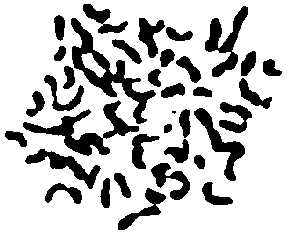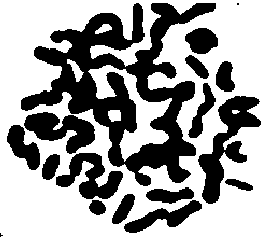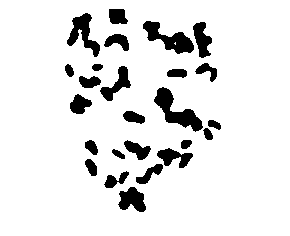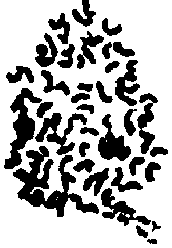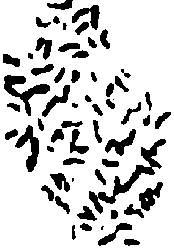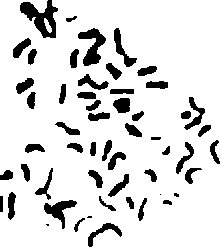 |
Hybridization of wild species amphiploids and cultivated varieties as a way of broadening the cultivated cotton genetical basis |
| Dr. Sergey Grigoryev |
 |
Cotton is cultivated in different soil-climatic areas each having entomofauna and microflora of its own. Due to the ongoing adaptive variation of pathogens and pests of cotton under the conditions of a vast agrocenosis, geneticists and breeders should keep on searching for new sources and donors of cotton resistance and adaptivity, and the varieties losing resistance should be replaced with new ones possessing a series of economically valuable characters.
Along with high yielding ability, modern varieties should have resistance to such abiotic environmental factors as temperature stress and water deficiency. It is obvious that under these conditions the range of adaptive potential of cotton should be extended through increasing genetical diversity of the cultivated varieties. The history of various crops cultivation is rich in examples of severe epiphytoties ruining the widely cultivated crops with poor genetical basis.Genetical basis of the cultivated cotton may be extended through involving wild species and distant forms of cotton into hybridization. When crossing species with different chromosome sets, polyploids should be used. The created amphiploid forms may serve as "links" when conveying useful properties from wild species to the cultivated forms.
Aim tasks of investigations
The aim of the present work was to study principles of involving into hybridization and selecting polyploid forms of cotton created on the basis of the cultivated species Gossypium hirsutum L., some wild species, and a subspecies G.hirsutum L., ssp.purpurascens.The research dealt with manifestation, recombination and inheritance of characters from wild and cultivated species in the polytester topcross with several modern cultivated varieties. The task was set to introduce in the optimal way genetical material of wild forms into the genome of cultivated varieties, with the least losses of valuable properties on the part of recipient varieties, and involve the obtained genetically enriched forms into breeding process. As a consequence, donor properties of the created amphiploids had to be evaluated. Also, genetical relations of potential donors and recurrent varieties concerning characters manifestation were studied, factor analysis of variance of contributions made by each amphiploid and variety to the hybrid made, and reaction of forms to the selected partner investigated.
Materials and methods
The amphiploids used in the research have been obtained through intraspecific hybridization of G.hirsutum L. varieties with the species G.lobatum Gen., G trilobum Skov., G.harknesii Brand. used as female forms. The form G.hirsutum L., ssp.purpurascens was also used in the research. Letters AP standing before the name of the incorporated wild species designate the amphiploid forms.
The cultivated varieties C-4880, C-4727, Namangan 77, and 1541 have been used as male forms. Hybridization with varieties differing from each other by properties and pedigree made it possible to reveal general and special combining abilities of amphiploids.
The hybrids have been studied in Tashkent Region (Uzbekistan), planted in 3-4 replications, against natural cotton wilt background. Plants affection with wilt (Verticillium dahliae Klebahn.) was recorded as per October 1 against a 6-point scale (according to Voytenok V.F., 1987, 1992); the pre-frost mass of raw cotton per plant has been recorded.
 |
Acetoarsenic staining has revealed the pentaploid chromosome number (2n=65)
The form showed photoperiodic reaction and has been grown under the conditions of a shortened 10-hour light day. Plant height is 66 to 70 cm, the bush is of spreading type, the 1-st sympodium is located at the 9-th to 10-th node; the number of monopodiums is 3 - 4. The boll is ovoid, with smooth surface. One boll weighs 48 g, staple is 30.9 mm long. Under the conditions of a test plot, affection with wilt was weak – 27.3% of the total plants. |
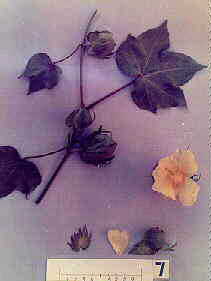 |
F17 (G.hirsutum x G.trilobum)
|
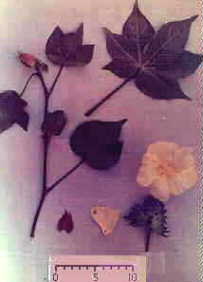 |
Cytological study of the form employing cytoarsenic staining has shown aneuploidy of cell caryotypes: 2n=52, 2n=60 and 2n=65.
Plant height is 90 to 100 cm. The bush is of spreading type. The first sympodium is located at the 9-th – 10-th node; the number of monopodiums is 1 – 2, and of sympodiums 18 to 20. The flower is of yellow colour, without the anthocyan spot. The boll is orbicular, with smooth surface, weighs 4.3 g. The number of bolls per plant is 22. The staple is 29.3 mm long. The form is strictly photoperiodic, and it was grown at a 10-hour light day. The plant with the most typical phenotype is shown on photo.
F10 (G.hirsutum x G.harknessi)
|
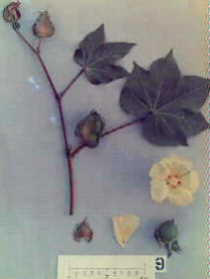
|
The form has amphidiploid chromosome set: 2n=72, 2n=74 and 2n=78.
The form is photoperiodic, and it was grown under the conditions of a shortened 10-hour light day. Plant height is 90 to 95 cm. The bush is of semi-spreading type; the first sympodium is located at the 9th node, the number of monopodiums is 2 on the average, and that of sympodiums is 19. A plant bears 27 bolls. This photo shows the plant with the most typical phenotype.
F9 G. hirsutum L., ssp.purpurascens.
Results
The polytester topcross that represents by itself crossing of three tester varieties, differing by origin and properties, with all the studied wild forms, allows an objective judgement on the manifestation of amphiploids in the progeny and hence make an assumption of their donor potential.
On the basis of the analysis of GCA effects and SCA variance of the wilt susceptibility character (negative values in the case of higher resistance), it may be concluded that wilt resistance is better realized by the forms AP (G.hirsutum x G.harknessi) and AP (G.hirsutum x G.lobatum), Table 1.
It is supposed that these two forms out of the 4 studied wild parents have the biggest negative values of GCA effect and may ensure stable high rate of wilt resistance in the progeny. Taking into account the minimal values of SCA variance for these two forms, realization of the wilt resistance character in hybrids has minimal dependence on the recurrent variety chosen as the cultivated parent.
However, the forms AP G.lobatum and AP G.harknessi have the smallest GCA values for plant yielding ability. Obviously, these forms transfer the character of low yield of raw cotton per plant when realizing the character of wilt resistance (Table 2).
The small SCA variance (4.2) of AP G.lobatum evidence that realization of the character of low yiled in hybrids depends in the least on the choice of the pair for crossing. Manifestation of low yielding ability from AP G.harknessi in its hybrids (SCA variance 28.4) would depend on the cultivated partner involved in crossing.
Realization of the high yield character in hybrids of AP G.trilobum (GCA effect +1.4) depends little on the choice of pair for crossing (SCA variance 1.3). Manifestation of the high yield character of ssp.purpurascens in hybrids (the highest value obtained in trials, GCA effect +5.6) depends to a great extent on the variety chosen for crossing.
Of value for breeding for staple length is the form AP (G.hirsutum x G.trilobum) that had the highest GCA effect value in the experiment (Table 3).
Proceeding from the minimum values of SCA variance in the trials, it may be supposed that realization of the long staple character of this form in its hybrids has minimum dependence on the partner chosen for crossing.
Values of wilt affection of F2 hybrids have been subjected to the analysis of variance. Middle of the vertical line represents the arithmetic mean of the points of affection, and the distance up and down is LSD Crossing with the forms AP G.harknessi and AP G.lobatum has the strongest influence on the increase of wilt resistance.
The values of raw cotton mass per healthy plant have been analyzed applying the same method.
Influence of the cultivated parent on the resulting hybrid plant yield is statistically insignificant (F-ratio=1.62).
It should be noted that yielding ability of hybrid plants was determined by wild forms, that is, the choice of a cultivated variety for crossing had no positive effect on yielding ability of hybrids.
When crossed with tester varieties, the form AP G.lobatum reliably redused plant yield, if compared to other wild forms, while the form ssp.purpurascens reliably had a strong increasing effect on the character. The effect is thanks to the largest size of the boll conveyed by ssp.purpurascens to the hybrids with tester varieties.
The wild forms involved in hybridization induce in hybrids a larger number of bolls per plant; the form AP G.harknessi has the strongest influence in this respect which is associated with small size of the boll of this form. In hybrids with AP G.lobatum the character of boll abundance has the minimum expression. This form realizes in its hybrids the boll small size character along with the smallest - out of all the forms studied - number of bolls per plant, and as a consequence the character of low yield is realized by the form in hybrid plants.
The reason of high per plant yields of the ssp.purpurascens hybrids lies in the fact that they have the largest boll in sufficient quantity per one plant.
Practical results
Also, it should be mentioned that the use of a number of non-transgressive hybrids (variability doesn’t exceed the limits of parental forms) allows creation of recombinants valuable for breeding tolerant forms.
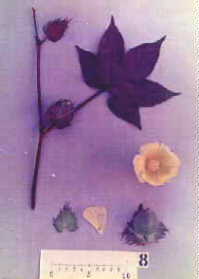 Plants are photoperiodic and were grown under the conditions of a 10-hour light day. Plant height is 110 cm. The number of monopodiums is 3.7 and that of sypodiums 20.9; location of the first sympodium is at the 12.4 nod. One boll weighs 3.0 g and their number per plant is 40. Staple is 27.1 mm long. Phenotype of the typical plant is given in right photo.
Plants are photoperiodic and were grown under the conditions of a 10-hour light day. Plant height is 110 cm. The number of monopodiums is 3.7 and that of sypodiums 20.9; location of the first sympodium is at the 12.4 nod. One boll weighs 3.0 g and their number per plant is 40. Staple is 27.1 mm long. Phenotype of the typical plant is given in right photo.
Table 1. Wilt affection analysis in the polytester topcross system
Amphiploids
GCA effect
SCA Variance
AP (G.hirsutum x G.lobatum)
-0.073
0.016
AP (G.hirsutum x G.trilobum)
+0.093
0.044
AP (G.hirsutum x G.harknessi)
-0.04
0.013
ssp.purpurascens
+0.027
0.016
Table 2. Yield analysis in the polytester topcross system
Amphiploids
GCA effect
SCA Variance
AP (G.hirsutum x G.lobatum)
-4.4
4.2
AP (G.hirsutum x G.trilobum)
+1.4
1.3
AP (G.hirsutum x G.harknessi)
-2.7
28.4
ssp.purpurascens
+5.6
56.5
Table 3. Staple length analysis in the polytester topcross system
Amphiploids
GCA effect
SCA Variance
AP (G.hirsutum x G.lobatum)
+0.1
0.27
AP (G.hirsutum x G.trilobum)
+0.2
0.07
AP (G.hirsutum x G.harknessi)
+0.1
0.09
ssp.purpurascens
-0.3
0.1
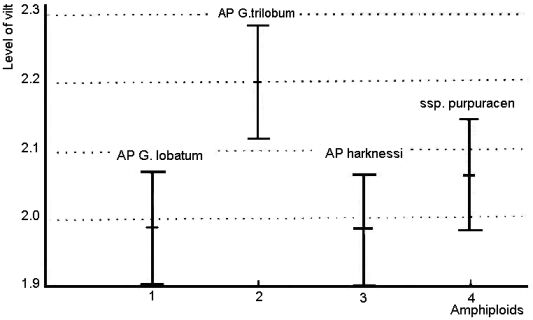
The effect of amphiploids on wilt resistance of hybrids in polytester topcrosses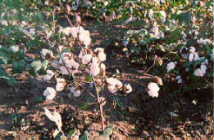 Wilt resistant, high yielding hybrids of amphiploids and varieties have been obtained. The selected wilt resistant, high yielding families are used in breeding programs in Southern Russia and Italy as the material created on a broader genetical basis. In the Krasnodar Territory, for instance, yield of some hybrids reached 70 g of raw cotton per plant.
Wilt resistant, high yielding hybrids of amphiploids and varieties have been obtained. The selected wilt resistant, high yielding families are used in breeding programs in Southern Russia and Italy as the material created on a broader genetical basis. In the Krasnodar Territory, for instance, yield of some hybrids reached 70 g of raw cotton per plant.
Hybridization of wild species amphiploids and cultivated varieties as a way of broadening the cultivated cotton genetical basis

